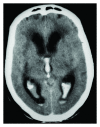Spontaneous primary intraventricular hemorrhage: clinical features and early outcome
- PMID: 22966468
- PMCID: PMC3433135
- DOI: 10.5402/2012/498303
Spontaneous primary intraventricular hemorrhage: clinical features and early outcome
Abstract
Purpose. Primary hemorrhage in the ventricular system without a recognizable parenchymal component is very rare. This single-center retrospective study aimed to further characterize the clinical characteristics and early outcome of this stroke subtype. Methods. All patients with primary intraventricular hemorrhage included in a prospective hospital-based stroke registry over a 19-year period were assessed. A standardized protocol with 161 items, including demographics, risk factors, clinical data, neuroimaging findings, and outcome, was used for data collection. A comparison was made between the groups of primary intraventricular hemorrhage and subcortical intracerebral hemorrhage. Predictors of primary intraventricular hemorrhage were identified by logistic regression analysis. Results. There were 12 patients with primary intraventricular hemorrhage (0.31% of all cases of stroke included in the database) and 133 in the cohort of subcortical hemorrhage. Very old age (≥85 years) (odds ratio (OR) 9.89), atrial fibrillation (OR 8.92), headache (OR 6.89), and altered consciousness (OR 4.36) were independent predictors of intraventricular hemorrhage. The overall in-hospital mortality rate was 41.7% (5/12) but increased to 60% (3/5) in patients aged 85 years or older. Conclusion. Although primary intraventricular hemorrhage is uncommon, it is a severe clinical condition with a high early mortality. The prognosis is particularly poor in very old patients.
Figures
Similar articles
-
Clinical features and functional outcome of intracerebral hemorrhage in patients aged 85 and older.J Am Geriatr Soc. 2002 Mar;50(3):449-54. doi: 10.1046/j.1532-5415.2002.50109.x. J Am Geriatr Soc. 2002. PMID: 11943039
-
Thalamic haemorrhage vs internal capsule-basal ganglia haemorrhage: clinical profile and predictors of in-hospital mortality.BMC Neurol. 2007 Oct 5;7:32. doi: 10.1186/1471-2377-7-32. BMC Neurol. 2007. PMID: 17919332 Free PMC article.
-
Race-Specific Predictors of Mortality in Intracerebral Hemorrhage: Differential Impacts of Intraventricular Hemorrhage and Age Among Blacks and Whites.J Am Heart Assoc. 2016 Aug 16;5(8):e003540. doi: 10.1161/JAHA.116.003540. J Am Heart Assoc. 2016. PMID: 27530120 Free PMC article.
-
[New methods of intensive therapy in stroke: hemicraniectomy in patients with complete middle cerebral artery infarction and treatment of intracerebral and intraventricular hemorrhage with urokinase].Ideggyogy Sz. 2002 Mar 20;55(3-4):118-27. Ideggyogy Sz. 2002. PMID: 12122981 Review. Hungarian.
-
The Ege Stroke Registry: a hospital-based study in the Aegean region, Izmir, Turkey. Analysis of 2,000 stroke patients.Cerebrovasc Dis. 1998 Sep-Oct;8(5):278-88. doi: 10.1159/000015866. Cerebrovasc Dis. 1998. PMID: 9712926 Review.
Cited by
-
Primary intraventricular haemorrhage: the role of frontal minicraniotomy and external ventricular drainage.BMJ Case Rep. 2021 Feb 9;14(2):e239448. doi: 10.1136/bcr-2020-239448. BMJ Case Rep. 2021. PMID: 33563669 Free PMC article.
-
Upward gaze palsy and convergence insufficiency as a rare presentation of primary intraventricular haemorrhage.BMJ Case Rep. 2021 Oct 12;14(10):e241340. doi: 10.1136/bcr-2020-241340. BMJ Case Rep. 2021. PMID: 34642217 Free PMC article.
-
A retrospective clinical study of 98 adult idiopathic primary intraventricular hemorrhage cases.Medicine (Baltimore). 2016 Oct;95(42):e5089. doi: 10.1097/MD.0000000000005089. Medicine (Baltimore). 2016. PMID: 27759637 Free PMC article.
-
Adult Primary Intraventricular Hemorrhage: Clinical Characteristics and Outcomes.J Neurosci Rural Pract. 2020 Oct;11(4):623-628. doi: 10.1055/s-0040-1716770. Epub 2020 Sep 25. J Neurosci Rural Pract. 2020. PMID: 33144801 Free PMC article.
-
Pediatric primary intraventricular hemorrhage: A case report of isolated fourth ventricle hemorrhage in a 10-year-old boy.Clin Case Rep. 2023 Sep 25;11(9):e7952. doi: 10.1002/ccr3.7952. eCollection 2023 Sep. Clin Case Rep. 2023. PMID: 37767151 Free PMC article.
References
-
- Kase CS, Mohr JP, Caplan LR. Intracerebral hemorrhage. In: Mohr JP, Choi DW, Grotta JC, Weir B, Wolf PA, editors. Stroke. Pathophysiology, Diagnosis, and Management . Philadelphia, Pa, USA: Churchill Livingstone; 2004. pp. 327–376.
-
- Kase CS. Subcortical hemorrhages. In: Donnan G, Norrving B, Bamford J, Bogousslavsky J, editors. Subcortical Stroke . 2nd edition. Oxford, UK: Oxford Medical; 2002. pp. 347–377.
-
- Caplan LR. Primary intraventricular hemorrhage. In: Kase CS, Caplan LR, editors. Intracerebral Hemorrhage . Newton, Mass, USA: Butterworth-Heinemann; 1994. pp. 383–401.
-
- Arboix A, Comes E, García-Eroles L, et al. Site of bleeding and early outcome in primary intracerebral hemorrhage. Acta Neurologica Scandinavica . 2002;105(4):282–288. - PubMed
LinkOut - more resources
Full Text Sources


